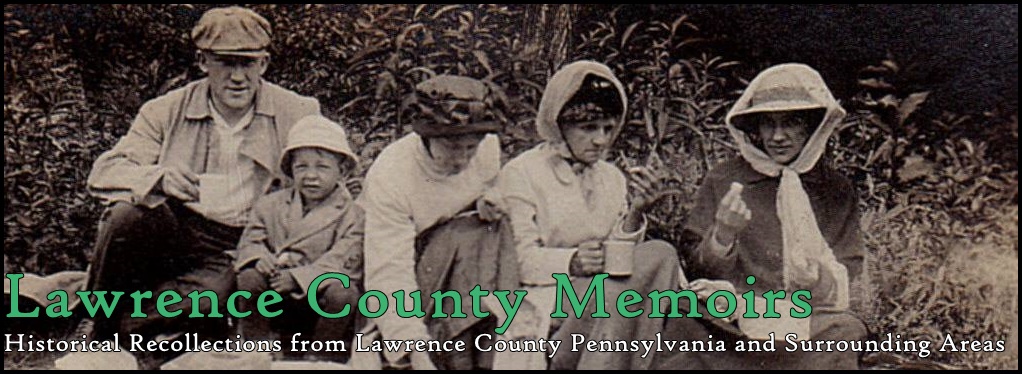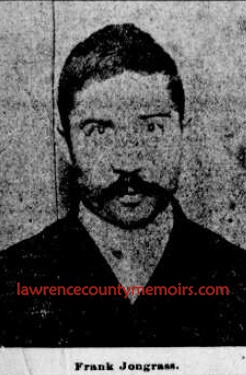Sometime in 1895 an Italian immigrant named Frank Jongrass, who originally settled in McKeesport, relocated to the small settlement of Hillsville, Pennsylvania. He had several family members residing in the area to include a half-brother named James Carrine and a brother named John Jongrass. James Carrine and his wife Mary had emigrated from Italy in 1890 and settled in Hillsville with their daughter Jessie and son Frank. John Jongrass was also a boarder in the Carrine home.
Frank Jongrass soon fell in love with Jessie Carrine, who was about eighteen years of age, and they began seeing each other despite the wishes of her parents. I not sure how old Jongrass was but I believe he was at least 10-15 years her senior. In about June 1896, after being forbidden to see Jessie anymore, Jongrass moved back to McKeesport. About a month later he received a letter from his brother John, informing him that Jessie wanted Frank to return to Hillsville and formally ask her parents for her hand in marriage. Jongrass returned to Hillsville on August 11, 1896, and attempted to talk with his half-brother James Carrine. An argument ensued and an irate James Carrine said if Frank ever returned he would summon the police. A dejected Jongrass returned to McKeesport.
All was presumably quiet until the night of October 6, 1896. Eyewitness accounts vary but at about 8:00pm an assailant – who was standing a good distance back – fired two bursts from a shotgun into the open front door of the Carrine family home and fled. The initial blast struck and instantly killed Jessie Carrine. A handful of witnesses heard or saw the shotgun blast but failed to clearly see the shooter in the darkness. Jessie’s father initially indicated to bystanders that he did not know who pulled the trigger, but he soon identified Frank Jongrass as the perpetrator.
The next day authorities in McKeesport arrested Jongrass as he was sleeping in his boarding house room. Jongrass, who was apparently ill and had visited a doctor the day prior, was taken to the local hospital for treatment. A few days later to was transported to New Castle and detained in the Lawrence County Jail.
He entered a plea of “not guilty” at his arraignment on first degree murder and manslaughter charges and his trial commenced in December 1896. Jongrass faced the death penalty for the alleged crimes. Along the way he had legal support from esteemed attorneys Davis B. Kurtz, Col. Oscar L. Jackson, and Frank Blackstone. Jongrass, who only spoke broken English, proclaimed his innocence and said he was at home and ill at the time of the shooting. He also said he was deeply in love with Jessie Carrine and would never harm her. The evidence against Jongrass was circumstantial and the murder weapon was never found. It was theorized that Jongrass went to Hillsville to kill his half-brother James Carrine, but accidently shot his sweetheart Jessie when she interfered. Supporters of Jongrass believe James Carrine may have accidently shot his own daughter. Anyway, on December 18 the jury returned a verdict of “guilty” on the first degree murder charge.
A motion for a retrial was immediately filed with the Lawrence County court, but the motion was denied on February 22, 1897. That same day Jongrass was sentenced to death by hanging. Various appeals were filed including one with the Supreme Court of Pennsylvania. His attorneys alleged that a juror apparently dozed off – at least momentarily – during the trial, but the appeal was denied in May 1897. His execution was scheduled for February 24, 1898.
At that time executions in Pennsylvania were handled by the local counties, and in this case Lawrence County Sheriff Charles Matthews would be responsible for the execution of Jongrass. It wasn’t until 1913 that that the state took over responsibility for all executions, when electrocution was mandated as the preferred method of execution.
On February 23, 1898, a day before his execution was to take place, Jongrass received a sixty-day reprieve from state officials in Harrisburg. This was apparently done at the request of the federal government, which had received an appeal on Jongrass’ behalf from the Italian government. Attorney Davis B. Kurtz had reportedly traveled to New York City a few weeks prior and met with officials at the Italian Consulate. The Italians apparently had a push to delay the execution but it was not very emphatic. Efforts continued for a pardon or reprieve for Jongrass but to no avail.
Two months later things were all quiet on the legal front and a last minute reprieve from Governor Daniel H. Hastings was not forthcoming. Just prior to 10:00am on the morning of Tuesday, April 26, 1898, Jongrass was taken from his cell in the Lawrence County Jail and led to the gallows set up in the courtyard. A nervous crowd gathered outside the courthouse and all were requested to maintain quiet by police officials. Jongrass was escorted by the Reverend Ubaldus Pandolfi of Boston, one of several priests who acted as a spiritual adviser.
The New Castle News reported this, “Jongrass was clean shaven, and was clad in a neat suit of black. He was pale, as any man who has spent 18 months in close confinement might be expected to be, but it was not the pale of fear. The man clearly realized his terrible position, but was cool and nervy… As Jongrass came to a pause after a firmly spoken sentence in which the word “innocent” was heard, Father Ubaldus kissed him goodbye. Then without waiting for prompting by the sheriff or deputy (Harold) Bleakley, who had taken the place of the priest on his left, Jongrass mounted the ten steps of the gallows with a firm step…” After a black shroud and noose were secured to his neck Jongrass reached out with his bound hands. It was reported, “He was trying to shake hands in farewell with the deputy who had shown him much kindness during his long imprisonment. Deputy Bleakley grasped his hand, and Jongrass said to him, “Good bye.” It was his last word.” A few seconds later Bleakley stepped back and the trap door was sprung. Jongrass is said to have died instantly, but was not pronounced dead until 10:18am.
Jongrass’ remains were placed in a casket and taken to St. Joseph Catholic Church in New Castle. The church was packed by Italians for the memorial service that commenced at 3:00pm. The service was assisted by the Reverend Frances J. Eger, the pastor of St. Joseph Church. Afterwards Jongrass’ remains, after being viewed by the mourners, were transported to Neshannock Township and buried in St. Joseph Cemetery. Jongrass went to his grave – which was presumably unmarked – with the distinction of being the first person ever to be legally put to death in Lawrence County.
To read an article describing the memorial service and burial of Frank Jongrass click on: BURIAL OF JONGRASS ARTICLE.





Comments
John Spondike #
The son of James and Mary – “Frank” mentioned in this article was my Great Grandfather.
Comment